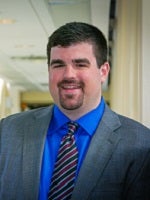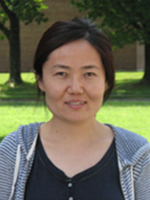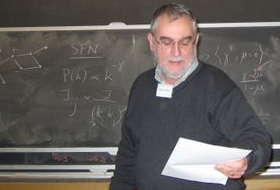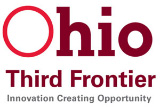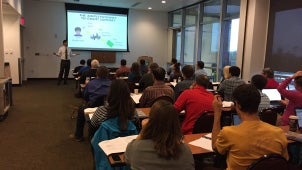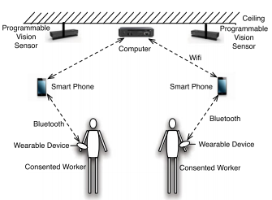| |
Top Story
Prof. Wirth Receives Industry Funding for Coatings Research
Chris Wirth, assistant professor in the Department of Chemical and Biomedical Engineering, has received funding from PPG Industries, Inc. to develop a novel method of monitoring coatings as they cure. The project has been funded $59,710 for one year and is titled “Development of a Particle Based Non-Invasive Inspection Technique for Paint.”
Dr. Wirth studies the behaviors of particles in fluids, particularly how those particles interact and assemble at interfaces. He and the team in his lab are interested in understanding fundamental relationships between particle interactions, microstructure, and bulk properties of colloids as well as industrial and medical applications for these phenomena.
For the PPG-funded research, Dr. Wirth will employ microscopy to track particles in paint coatings in 2D and 3D. This technique, which he calls “microrheology,” can provide insight into the effects that parameters such as film thickness and evaporation rate have on the material properties of a paint coating. A better understanding of the drying process can potentially lead to reduced coating defects, resulting in improved performance.
[Return to Top]

|
Meet CSU's New Faculty
Geyou Ao, Department of Chemical and Biomedical Engineering
Dr. Geyou Ao joined Cleveland State University in fall 2016 as an assistant professor in the Department of Chemical and Biomedical Engineering. She received her Ph.D. in chemical engineering with a focus on liquid crystalline phase behavior and rheology of carbon nanotubes in 2012 from Auburn University. Prior to joining CSU, Dr. Ao was a guest researcher at the National Institute of Standards and Technology (NIST).
Dr. Ao studies the structure-processing-property relationships in nanomaterials, with a special interest in structure selection and self-assembly of bio/nano hybrid molecules. She is especially interested in post-synthesis separation of nanomaterials such as carbon nanotubes (CNTs) and boron nitride nanotubes (BNNTs) with specific structures using DNA recognition sequences. She also studies the phase behavior and rheology of nanostructures in a liquid medium to predict and control their macroscopic properties. Dr. Ao is developing applications for structurally controlled nanomaterials such as using intrinsic near-infrared photoluminescence of CNTs for biological imaging, exploring advanced flame retardant coatings, and providing temperature and corrosion protection for aerospace applications using BNNTs. She is a member of the American Institute of Chemical Engineers, the American Chemical Society, and the Society of Rheology.
[Return to Top]
|

|
Featured Researcher Video Series
Nick Zingale
Research by Professor Nick Zingale is the focus of the latest installment of the Featured Researcher Video series. Click here to watch. |
Did You Know?
New Indirect Cost (F&A) Rates
CSU has a new Facilities and Administrative (F&A) Rate Agreement with the federal government. Principal Investigators and department staff should use these rates for all in-process and future proposals. The On-Campus indirect rate for research is 48.5% and the Off-Campus rate is 16%. This rate agreement is effective until 6/30/2020. For proposals that have already been submitted or funded, the indirect rate that was used in the proposal will be honored by the University.
If you have any questions or concerns, contact SPRS by email: m.kocevar@csuohio.edu.
|
[Return to Top]

|
CSU Scholar News
Miron Kaufman, Innovative Thinking in Physics
Miron Kaufman is a professor in the Department of Physics whose research in statistical and fluid mechanics has involved the areas of superconductivity, magnetism, liquids, polymers, hierarchical lattices and pattern formation in laminar flows. His publications have been referenced 1800 times with an h-index of 24. He has not limited his work to physics alone, and has more recently participated in NIH- and NSF-supported collaborative research projects at the interfaces of statistical physics with cognitive science, urban studies, polymer engineering and electrical engineering. These interdisciplinary studies have included:
- Phase transitions undergone by solids with defects and solid to gas sublimation transition
- Mixing in microfluidic devices and polymer extruders
- A social physics model of complex conflicts
- Complexity of time series from 4G/LTE wireless communications
Dr. Kaufman earned his PhD in physics from Carnegie Mellon University, and pursued postdoctoral research at MIT in phase transitions and critical phenomena associated with random magnetic fields and percolation. He joined CSU in 1985 and since his arrival he has continuously modernized and improved the physics program through improved laboratories, updates to the physics curriculum, and novel pedagogy that unifies experimental, computational, and theoretical physics. He developed the MS program in Medical Physics and currently co-directs the CSUteach program.
[Return to Top]
|

|
Inspired Creativity
Charles Hersch, Jews and Jazz: Improvising Ethnicity

Jews and Jazz: Improvising Ethnicity
(by Charles Hersch) |
Professor Charles Hersch, Chair of the Department of Political Science, has published a new book. Jews and Jazz: Improvising Ethnicity examines the meaning of Jews’ involvement in the world of American jazz. The book reveals how Jewish musicians and industry figures from Benny Goodman to John Zorn explored and constructed ethnic identities through their engagements with jazz. Jews and Jazz demonstrates how Jews’ involvement in jazz has mirrored ongoing changes in American Jewish identity.
In the 1920s and 1930s, when Jews were seen as foreigners, Jewish jazz musicians fought for a more inclusive America, for themselves and for blacks, establishing their American identity. As Jews became more accepted in the 1940s, musicians wary of assimilation played and marketed jazz to identify with African Americans and “re-minoritize.” Finally, beginning in the 1960s and continuing to this day, Jews have created jazz that explores and advances their identities as Jews in a multicultural society.
[Return to Top]
|

|
News from the Technology Transfer Office
Industry Collaboration for Joint Patent
The first CSU-Parker Hannifin joint patent application is being prepared for filing with the USPTO. Dr. Jerzy Sawicki and his doctoral student Curt Laubscher from the Department of Mechanical Engineering are the CSU inventors and Dr. Ryan Farris and Steven Etheridge are the Parker Hannifin inventors. The invention is titled Actuator for Powered Pediatric Lower Limb Orthosis, and the technology provides a lightweight and compact design with high efficiency and full-back drivability. It also affords quiet operation using toothed belt transmissions with adjustable belt tension.
|
|
Invention Disclosure Pipeline
The Technology Transfer Office (TTO) is currently reviewing an invention disclosure for a new chip design to create miniaturized, layered human tissues on a pillar plate and well plate, submitted by assistant professor Moo-Yeal Lee in the Department of Chemical & Biomedical Engineering. Dr. Lee’s invention, Pillar and Well Structures for Microarray 3D BioPrinting, has been under development for over one year and is sponsored in part by the NIH and EPA.
|
Third Frontier TVSF Deadline
The deadline to prepare an application for TVSF funding under the 2016 Round 13 RFP is December 15, 2016.
The Ohio Third Frontier created the TVSF to support economic growth through start-up companies that commercialize technologies developed in Ohio's higher education and not-for-profit research institutions. Contact Jack Kraszewski if you intend to submit a TVSF proposal. |
[Return to Top]

|
Events
Successful Grant-Writing Seminars, Possible Future Workshop
The Office of Research sponsored two successful grant writing seminars, one on October 14 which focused on arts and humanities, and the other on October 21 which focused on science and engineering. The full-day seminars were attended by over 40 faculty members, ranging from first-year assistant professors to tenured full professors. Participants rated the seminar extremely well: on a scale of 1 (lowest) to 5 (highest), the average post-seminar evaluation scores were 4.8. Comments provided by participants included: "Very informative. Inspired to begin writing [my] proposal." and "Fantastic, informative, engaging. Appreciate the newest updates to NSF/NIH requirements."
Extended Workshop Series: To build on the success of these seminars, the Office of Research is considering arranging an extended workshop series next year, which would be offered by the same organization that offered the seminars. The workshop would span several months and would include both individual and group consulting and critiquing of individual proposals on a rigorous schedule. The workshop would begin with the inception of a proposal idea and would finally result in a fully completed, critically reviewed proposal that would be submitted to an external funding agency. Proposals developed in the workshop could focus on any funding agency and any discipline. The workshop is based on the Grant Application Writer’s Workbook.
If you attended one of the Office of Research grant-writing seminars in November 2015 or October 2016, and if you are interested in participating in an intensive proposal-writing workshop, and if you can obtain the workshop registration fee of $4,000 from start-up funds, your College, or some other source, please email Dan Simon at d.j.simon@csuohio.edu.
[Return to Top]
|

|
Research Communications
Research Magazine Published, Preparation for Second
The Office of Research is pleased to announce the publication of the first CSU research magazine, which can be accessed by clicking here. The magazine features research highlights from across the University in areas such as science, engineering, law, urban studies, education, mathematics, history, art, and music.
Request for Nominations / Volunteers
The Office of Research is beginning to plan for a second edition of the magazine to be released next year, and is asking for nominations or volunteers to serve on the editorial board. If you are interested in planning and organizing the next CSU research magazine, please email Dan Simon at d.j.simon@csuohio.edu. |
Recognition
Undergraduate Research Leads to Peer Reviewed Article
Professor Wenbing Zhao from the Department of Electrical Engineering and Computer Science (EECS) and a team of researchers from EECS, the School of Health Sciences, and the School of Nursing have written an article titled “A Human-Centered Activity Tracking System: Toward a Healthier Workplace” that has been published in the IEEE Transactions on Human-Machine Systems.
Current EECS student Connor Gordon and 2016 graduate Abou-Bakar Fofana were co-authors on the paper, and helped to develop the system through an Undergraduate Summer Research Award.
Congratulations Connor, Dr. Zhao, and team!
|
[Return to Top]

|
Notice
New FLSA Requirement for Minimum Postdoctoral Salaries
The U.S. Department of Labor (DOL) released the final rule extending overtime protection for employees (including postdoctoral fellows and research associates) with salaries less than $47,476. The new rule goes into effect December 1, 2016 and requires that these employees be paid overtime at 1.5x the normal hourly rate for any hours over 40 hours per week. To comply with the new Fair Labor Standards Act (FLSA) rules, the minimum postdoctoral salary/stipend must be raised to the $47,476 by December 1, 2016.
Effective November 1, 2016, new proposal submissions that include support for a postdoc or related research position must budget a salary that meets or exceeds the $47,476 threshold. NIH has announced increased stipend levels for NRSA-supported postdocs effective Dec. 1, 2016, and NSF expects that all new grants will comply with the institution’s policy on postdoc salaries (see FAQs).
For proposals that have been submitted and are awaiting a decision for funding, PIs must ensure that postdoc salaries meet or exceed the new FLSA minimum salary threshold. PIs should follow normal SPRS rebudget procedures if redistribution of funds is required. This includes completing the IPAF and submitting it to Sponsored Programs & Research Services (SPRS).
[Return to Top]
|

|
Internal Funding
Changes to USRA, DRA, FRD, and FSI Funding
The Office of Research is pleased to announce the call for proposals for the 2017-2018 internal funding programs.
The application process and requirements have significantly changed since last year, including earlier submission deadlines. In order to assist in the preparation of successful applications, the forms that will be used to evaluate the proposals are included at the above web sites. For more information please contact Joy Yard, 687-9364, j.yard@csuohio.edu or Dan Simon, 687-5171, d.j.simon@csuohio.edu.
[Return to Top]
|
_____________________________________________________________________________________________
Please share with us important news or updates on your research, scholarly, or creative activities. Updates may be related to a paper that has been accepted for publication in a high-impact journal, a book you've just published, your work that will be exhibited at a prominent institution, or other updates you wish to share with our office. Send details to j.yard@csuohio.edu and d.j.simon@csuohio.edu.
_____________________________________________________________________________________________
This newsletter is compiled and published by
The Office of Research
|
|


